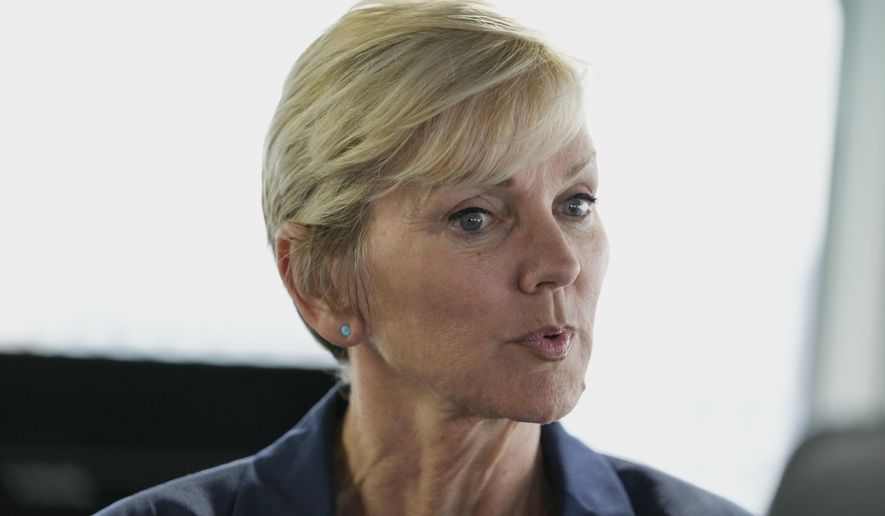A version of this story appeared in the daily Threat Status newsletter from The Washington Times. Click here to receive Threat Status delivered directly to your inbox each weekday.
The United States is building the first new nuclear warhead in 40 years but will do so without nuclear testing, Energy Department officials told Congress on Wednesday.
The W93 warhead will be used on submarine-launched ballistic missiles and is being built with $19.8 billion requested by the National Nuclear Security Agency, or NNSA, for weapons in fiscal 2025, according to Senate testimony by Energy Secretary Jennifer Granholm and NNSA Administrator Jill Hruby.
The W93 has been in an early phase of feasibility and design at Los Alamos National Laboratory since May 2022 and is “on track” for production beginning in the mid-2030s, the two officials said in prepared testimony to the Senate Armed Services Committee.
Nuclear forces modernization is the Pentagon’s top priority, and the Navy’s nuclear-missile submarines are considered the linchpin of U.S. strategic nuclear forces, which also include ICBMs and bombers.
NNSA stated on its website that the W93 “will allow the U.S. to keep pace with future adversary threats.”
All nuclear components will be based on currently deployed and previously tested nuclear designs.
The W93 will include modern technologies, such as insensitive high explosives used for triggering. Other new features will include improved safety, security and flexibility “to address future threats,” the NNSA said.
The warhead is said to be lighter than the current W76 and W88 warheads, allowing greater missile ranges.
The nuclear missile submarine forces will be scaled down from 14 Ohio-class submarines to 12 Columbia-class missile boats.
The department is also modernizing five warhead types — the B61-12 life extension program, the B61-13, the W88, W87, and W80 warheads under a funding request of $2.84 billion, the two officials’ testimony states.
The B61 is a nuclear gravity bomb dropped by aircraft, and the newer variant will be built by 2025.
The Biden administration, however, failed to request funds for the new submarine-launched cruise missile-nuclear, known as SLCM-N in the current budget, the two officials stated, blaming the timing of last year’s defense authorization enactment.
The SLCM-N likely will be armed with the W80 warhead, Ms. Hruby said in a committee hearing.
The W80 will also be used on the Air Force’s new air-launched, long-range missile.
Congress demanded the nuclear cruise missile in legislation after its development was opposed by the administration.
NNSA will continue to work with the Pentagon and Congress to comply with the law, the officials said.
The Pentagon-Energy Nuclear Weapons Council ordered development of the new warhead to be sped up and the funds requested for it will seek to achieve that, Ms. Granholm and Ms. Hruby’s testimony states.
“The W93 is a new warhead program based on existing designs that will not require new underground nuclear explosive testing,” the two women stated.
The number used for the warhead — W93 — is the latest effort at a new warhead. The W89 and W92 were canceled after the fall of the Soviet Union in 1991.
The United States is adhering to a nuclear testing moratorium despite the Senate having rejected the proposed Nuclear Test Ban Treaty in 1999.
“The W93 will meet DoD requirements to enhance operational effectiveness of the U.S. ballistic missile submarine force,” Ms. Granholm and Ms. Hruby said.
Plutonium pits for the warhead will be produced at Savannah River National Laboratory in South Carolina.
The warhead, which was requested by Adm. Charles Richard in late 2020 when he was commander of the Omaha-based Strategic Command, will being built with assistance from the British government, which also will be deploying the weapon.
Adm. Richard, who retired in January 2023, was the first nuclear forces commander to sound the alarm on what he termed China’s nuclear “breakout.”
China has doubled its nuclear warhead stockpile and has begun deploying multi-warhead intercontinental ballistic missiles at three large missile fields in western China.
These fields could include up to 360 missiles, military officials have said.
• Bill Gertz can be reached at bgertz@washingtontimes.com.




Please read our comment policy before commenting.